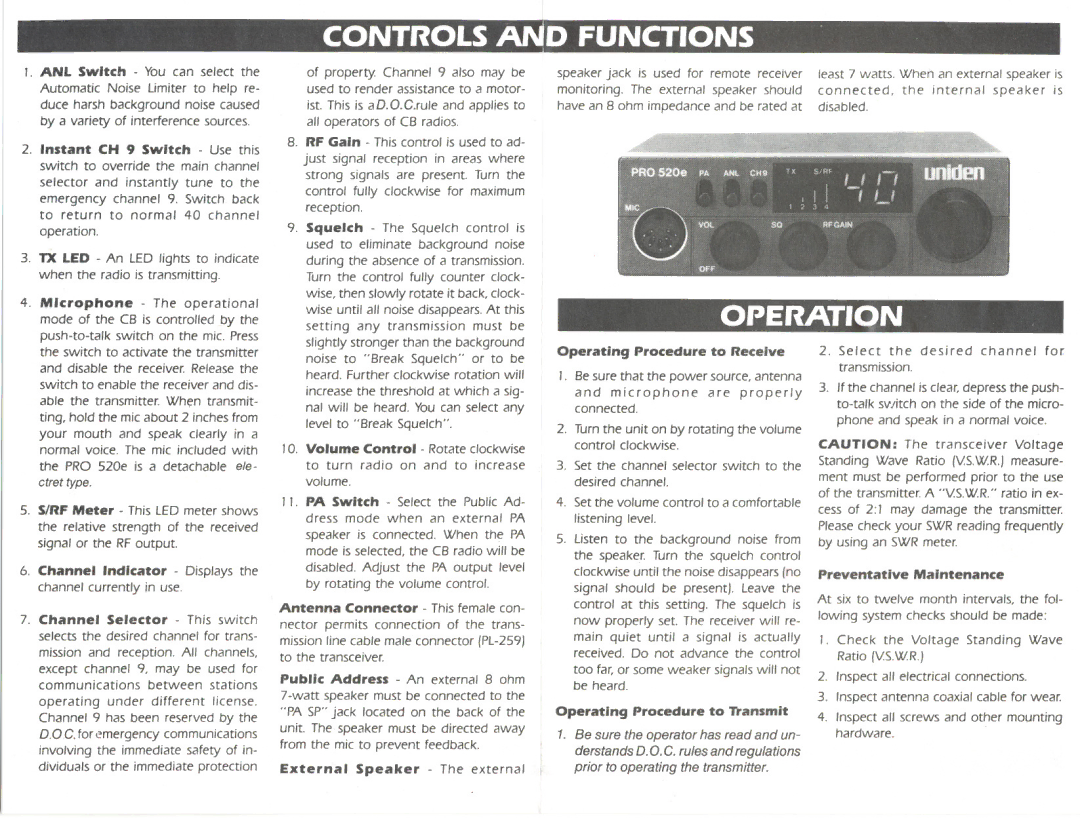
CONTROLS DFUNCTIONS
,. ANL Switch - You can select the | |
Automatic Noise limiter to help re- | |
duce harsh background noise caused | |
by a variety of interference sources. | |
2. Instant CH 9 Switch - Use this | |
switch to override the main channel | |
selector and instantly tune to the | |
emergency channel 9. Switch back | |
to return to normal 40 channel | |
operation. |
|
3. TX LED - An LED lights to indicate | |
when the radio is transmitting. | |
4. Microphone | - The operational |
mode of the CB is controlled by the | |
of property. Channel 9 also may be used to render assistance to a motor-
ist. This is aD. O. C.rule and applies to all operators of CB radios.
8.RF Gain - This control is used to ad-
just signal reception in areas where strong signals are present. Turn the control fully clockwise for maximum reception.
9. Squelch - The Squelch control is |
used to eliminate background noise |
during the absence of a transmission. |
Turn the control fully counter clock- |
wise, then slowly rotate it back, clock- |
wise until all noise disappears. At this |
setting any transmission must be |
slightly stronger than the background |
speaker jack is used for remote receiver least 7 watts. When.;tn external speaker is
monitoring. The external speaker should connected, the inre,[nal speaker is
Ihave an 8 ohm impedance and be rated at disabled.
OPERATION
,""
the switch to activate the transmitter | |||
and disable the receiver. Release the | |||
switch to enable the receiver and dis- | |||
able the transmitter. Wh~n transmit- | |||
ting, hold the mic about 2 inches from | |||
your mouth and speak clearly in a | |||
normal voice. The mic included with | |||
the PRO 520e is a detachable ele- | |||
ctret type. |
|
|
|
5. S/RF Meter - This LED meter shows | |||
the relative strength of the received | |||
signal or the RF output. |
| ||
6. Channel Indicator - Displays the | |||
channel currently | in use. |
| |
7. Channel Selector | - This switch | ||
selects the desired channel for trans- | |||
mission and reception. All channels, | |||
except channel 9, may be used for | |||
communications | between | stations | |
operating under | different | license. | |
Channel 9 has been reserved by the | |||
D.OC. for emergency | communications | ||
involving the immediate safety of in- | |||
dividuals or the immediate protection | |||
noise to "Break Squelch" or to be |
heard. Further clockwise rotation will |
increase the threshold at which a sig- |
nal will be heard. You can select any |
level to "Break Squelch". |
'0. Volume Control - Rotate clockwise to turn radio on and to increase volume.
,,. PA Switch - Select the PublicAd- dress mode when an external PA
speaker is connected. When the PA mode is selected, the CB radio will be disabled. Adjust the PA output level by rotating the volume control.
Antenna Connector - This female con-
nector permits connection of the trans- mission line cable male connector
Public Address - An external 8 ohm
External Speaker - The external
I Operating Procedure to Receive
,. Be sure that the power source, antenna
and microphone are properly
Iconnected.
I2. Turn the unit on by rotating the volume control clockwise.
3.Set the channel selector switch to the desired channel.
I4. Set the volume control to a comfortable listening level.
5.listen to the background noise from the speaker. Turn the squelch control clockwise until the noise disappears (no signal should be present). Leave the control at this setting. The squelch is now properly set. The receiver will re-
main quiet until a signal is actually received. Do not advance the control
too far, or some weaker signals will not be heard.
: Operating Procedure to D'ansmit
1.Be sure the operator has read and un- derstands D. O. C. rules and regulations prior to operating the transmitter.
2. Select the desired channel for transmission.
3.Ifthe channel is clear, depress the push-
phone and speak in a normal voice.
CAUTION: The transceiver Voltage Standing Wave Ratio (VS.W.R.)measure-
ment must be performed prior to the use of the transmitter. A "VS.WR." ratio in ex-
cess of 2:' may damage the transmitter. Please check your SWRreading frequently by using an SWR meter.
Preventative Maintenance
At six to twelve month intervals, the fol- lowing system checks should be made:
,.Check the Voltage Standing Wave Ratio (VS.WR.)
2.Inspect all electrical connections.
3.Inspect antenna coaxial cable for wear.
4.Inspect all screws and other mounting hardware.
